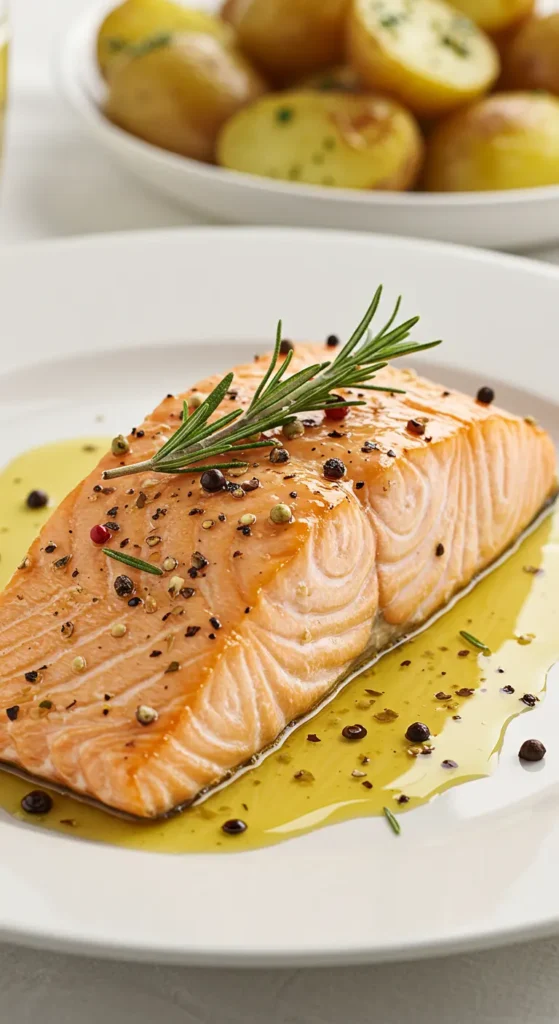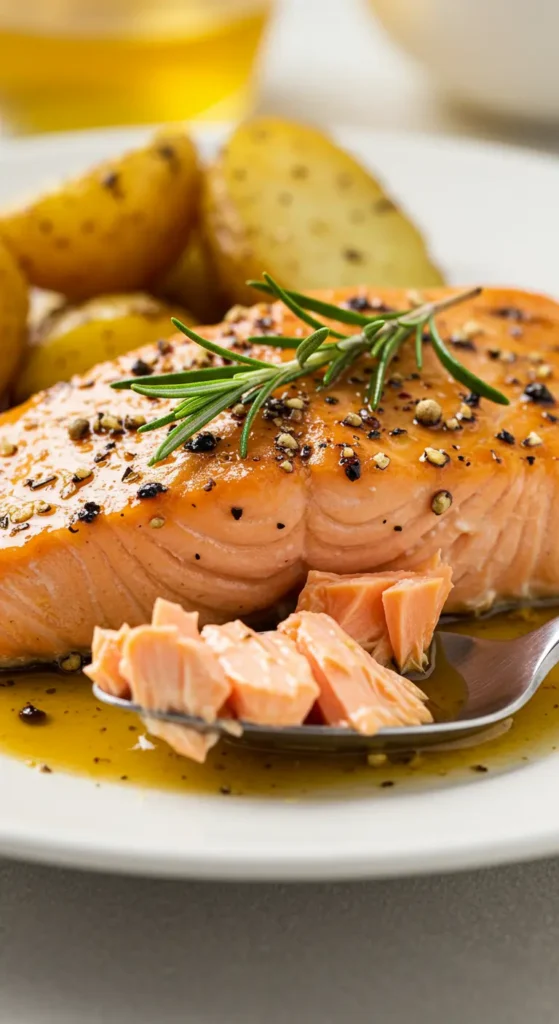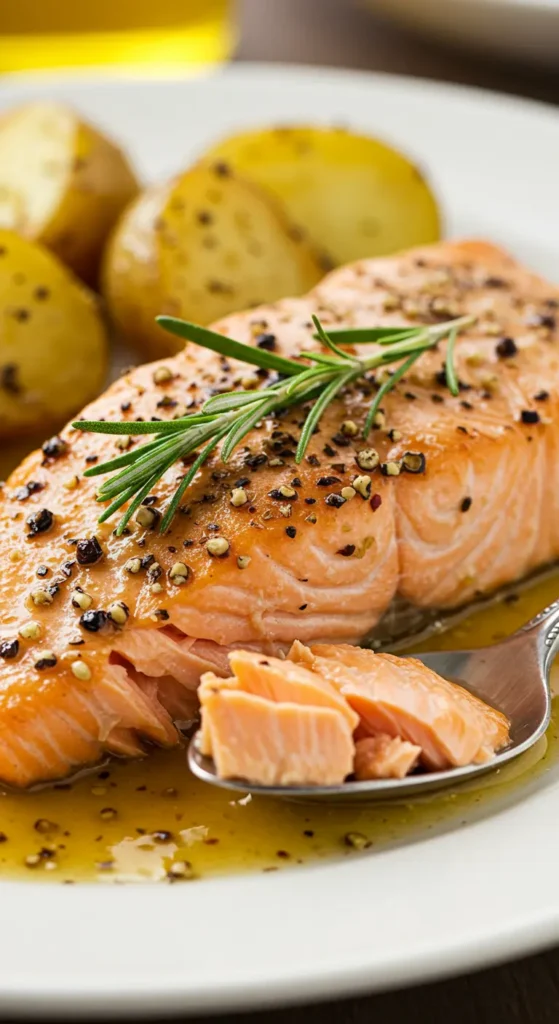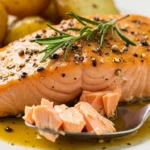Have you ever tasted restaurant-quality Brine smoked salmon and wondered if you could recreate that perfect balance of smoky flavor and silky texture at home? I’m thrilled to share that you absolutely can! After years of perfecting my technique, I’ve discovered that the secret to truly exceptional smoked salmon lies in the brining process—a culinary game-changer that transforms ordinary salmon into something extraordinary.

Table of Contents
When you combine the ancient preservation technique of brining with the aromatic magic of wood smoking, something remarkable happens. The salt brine not only seasons the salmon throughout but creates the ideal foundation for that coveted pellicle—that slightly tacky surface that allows smoke to adhere beautifully to your fish. Whether you prefer the gentle approach of cold smoking or the quicker method of hot smoking, this preparation enhances the salmon’s natural omega-3 richness while infusing it with complex flavors that simply can’t be store-bought.
I’ve tested countless variations of this recipe in my home kitchen, adjusting brining times and experimenting with different wood chips until landing on this foolproof method. What I love most is how versatile this technique is—once you master the basics, you can customize the flavor profile to suit any occasion, from delicate dill and lemon for elegant brunches to bolder spice blends for creative dinner applications.
Ingredients Needed
For the Brine:
- 1 cup kosher salt (If you only have table salt, reduce to ⅔ cup as it’s more concentrated)
- ½ cup brown sugar (Light or dark both work; maple sugar makes a lovely substitute)
- 2 tablespoons whole black peppercorns (Pre-ground pepper works in a pinch, use 1 tablespoon)
- 4 bay leaves (Don’t have them? Try 1 teaspoon of thyme instead)
- 1 bunch fresh dill, roughly chopped (Dried dill works too—use 2 tablespoons)
- 2 lemons, zested and juiced (Orange zest offers a delightful alternative)
- 4 cups cold water
For the Salmon:
- 2 pounds fresh salmon fillets, skin-on (Look for wild-caught when possible, but farm-raised works well too)
- If you can’t find fresh salmon, frozen works surprisingly well—just thaw completely in the refrigerator
For Smoking:
- 2 cups wood chips—alder is traditional, but apple or cherry wood create wonderful flavor
- No smoking equipment? I’ll share an oven method that mimics the smoke flavor using liquid smoke (¼ teaspoon mixed into your brine)
Optional Flavor Boosters:
- 3 cloves garlic, crushed (Garlic powder works too—use ½ teaspoon)
- 1 tablespoon whole coriander seeds (Ground coriander is fine—use 1 teaspoon)
- 2 tablespoons vodka or bourbon (Adds complexity but can be skipped)
- 1 tablespoon juniper berries (If unavailable, add an extra teaspoon of black pepper)
How to Make
1. Prepare the Brine
- In a large bowl, combine the cold water, kosher salt, and brown sugar. Whisk until completely dissolved—this usually takes about 2 minutes of steady stirring.
- Add the peppercorns, bay leaves, dill, lemon zest, and lemon juice to the salt solution. If you’re using any optional flavor boosters, add them now.
- Stir the mixture thoroughly to ensure all aromatics are well distributed throughout the brine.
2. Prepare the Salmon
- Examine your salmon fillets and remove any pin bones using tweezers or needle-nose pliers. Run your fingertips along the flesh to feel for any small bones that might remain.
- Cut the salmon into portions about 4-6 inches in length—this allows for more even brining and smoking.
3. Brine the Salmon
- Place your salmon pieces in a glass or non-reactive container, then pour the brine over them, ensuring each piece is fully submerged. (If pieces float, place a small plate on top to keep them under the brine.)
- Cover the container and refrigerate for 8-12 hours. For thinner fillets (under 1-inch thick), stick to the shorter time; for thicker cuts, use the full 12 hours.
4. Form the Pellicle
- After brining, remove the salmon from the solution and rinse thoroughly under cold water to remove excess salt.
- Pat the fillets completely dry with paper towels.
- Place the salmon on a wire rack over a baking sheet, skin-side down.
- Allow the salmon to air-dry in the refrigerator, uncovered, for 2-4 hours. This crucial step forms the pellicle—a slightly tacky, dry surface that helps the smoke adhere to the fish. You’ll know it’s ready when the surface feels slightly tacky and has a slight sheen.
5. Prepare Your Smoker
- Soak your wood chips in water for at least 30 minutes, then drain.
- Preheat your smoker to a low temperature—ideally between 165°F and 175°F for cold smoking.
- Add your soaked wood chips according to your smoker’s instructions.
6. Smoke the Salmon
- Once your smoker has reached the proper temperature and is producing good smoke, place your salmon pieces on the rack, skin-side down, with space between each piece for smoke circulation.
- For cold smoking (below 180°F), smoke for 3-4 hours. For hot smoking (180°F-225°F), smoke until the internal temperature reaches 145°F, approximately 1-2 hours.
- The salmon is done when it flakes easily with a fork but still maintains moisture. The color will deepen to a beautiful burnished golden-orange.
7. Rest and Store
- Allow the smoked salmon to cool completely on a wire rack before wrapping.
- Once cooled, wrap tightly in parchment paper, then aluminum foil or plastic wrap.

Expert Tips/Variations and Substitutions
The Perfect Pellicle: If you’re struggling to develop that essential tacky surface, try using a small fan on low speed directed near (not at) your salmon during the drying phase. This gentle air circulation works wonders! A properly formed pellicle should feel slightly sticky to the touch and have a subtle sheen.
Temperature Precision: Keep a reliable thermometer in your smoker at all times. Temperature fluctuations are the enemy of perfectly smoked salmon. For cold smoking (below 180°F), consistency is even more crucial than the exact temperature itself.
Salt Selection Matters: Different salts have dramatically different volumes for the same weight. I strongly recommend using Diamond Crystal kosher salt for this recipe. If you use Morton’s kosher salt, reduce the amount by 25% as it’s denser.
The Water Test: Not sure if your fish is properly brined? Drop a small piece in a cup of water. If it floats, it’s ready for smoking. If it sinks, it needs more brining time.
Equipment Alternatives
Not everyone has a dedicated smoker, and that’s perfectly fine! Here are tested alternatives:
- Grill Method: Turn half your gas or charcoal grill into a smoker by placing soaked wood chips in a foil pouch with holes poked in the top. Place this over direct heat and the salmon on the cooler side.
- Stovetop Smoker: These compact units work surprisingly well for small batches. Add a tablespoon of wood chips to the base and follow manufacturer instructions.
- Oven Workaround: While not true smoking, you can approximate the flavor by adding 1/4 teaspoon liquid smoke to your brine, then slow-roasting the salmon at 225°F until it reaches 145°F internally.
Flavor Variations
The beauty of brining is how easily you can customize the flavor profile. Here are three of my favorite variations:
Nordic Style: Add 2 tablespoons crushed juniper berries, 1 tablespoon caraway seeds, and extra dill to your brine. This creates a traditional Scandinavian flavor perfect for holiday gatherings.
Asian Fusion: Replace half the water with soy sauce, add 2 tablespoons grated ginger, 3 star anise pods, and 1 tablespoon rice vinegar. This creates a complex umami profile that pairs beautifully with rice dishes.
Maple Bourbon: Substitute maple syrup for the brown sugar and add 3 tablespoons of your favorite bourbon to the brine. The resulting salmon has a subtle sweetness that’s irresistible on a breakfast bagel.
Troubleshooting Common Issues
Too Salty: If your finished salmon tastes too salty, your brining time was likely too long. Next time, reduce by 2-3 hours and ensure you’re thoroughly rinsing after brining.
Dry Texture: This usually indicates the smoking temperature was too high. Keep it low and slow—patience yields silky results.
Insufficient Smoke Flavor: Try using smaller wood chips or even wood dust for better smoke production. Also, ensure your pellicle is properly formed before smoking.

Serving Suggestions
Classic Breakfast & Brunch Options
Nothing beats the traditional combination of smoked salmon with cream cheese. I love setting up a DIY bagel bar when hosting brunch—it’s always a crowd-pleaser! Arrange your thinly sliced smoked salmon on a platter surrounded by:
- Toasted bagels (everything bagels are my personal favorite)
- Whipped cream cheese (try mixing in fresh herbs for extra flavor)
- Thinly sliced red onions soaked briefly in ice water to remove their bite
- Capers, rinsed and patted dry
- Lemon wedges for a fresh squeeze
- Fresh dill sprigs
- Sliced cucumber rounds
For a more substantial breakfast, try folding flakes of your smoked salmon into scrambled eggs just before they finish cooking. The residual heat will warm the salmon without cooking it further—absolutely divine with a sprinkle of chives on top!
Elegant Appetizers
When I want to impress dinner guests, I turn to these sophisticated yet simple appetizers:
- Smoked Salmon Canapés: Top small pieces of pumpernickel or rye bread with a thin layer of crème fraîche, a small piece of salmon, and a sprig of fresh dill.
- Cucumber Rounds: Replace crackers with crisp cucumber slices topped with a dot of horseradish cream, smoked salmon, and a tiny sprig of dill.
- Deviled Eggs with Smoked Salmon: Fold finely chopped smoked salmon into your deviled egg filling for an unexpected twist on this classic.
Main Course Applications
Your brine smoked salmon elevates these dishes from ordinary to extraordinary:
- Pasta Prima Donna: Toss hot pasta with a light cream sauce, then fold in pieces of smoked salmon and fresh peas just before serving.
- Luxurious Salad: Create a restaurant-worthy salad with mixed greens, shaved fennel, segments of orange, smoked salmon, and a light citrus vinaigrette.
- Savory Breakfast Bowl: Layer warmed quinoa with avocado slices, a soft-boiled egg, smoked salmon, and a drizzle of olive oil for a protein-packed start to your day.
Perfect Pairings
The right beverage can elevate your smoked salmon experience:
For wine lovers, I suggest a crisp, acidic white like Sancerre or Albariño that cuts through the richness of the salmon. If you prefer red, a light Pinot Noir works beautifully.
For cocktail enthusiasts, nothing complements smoked salmon quite like a classic Bloody Mary garnished with a small piece of your creation.
Brine Smoked Salmon
Ingredients
For the Brine:
- 1 cup kosher salt If you only have table salt, reduce to ⅔ cup as it’s more concentrated
- ½ cup brown sugar Light or dark both work; maple sugar makes a lovely substitute
- 2 tablespoons whole black peppercorns Pre-ground pepper works in a pinch, use 1 tablespoon
- 4 bay leaves Don’t have them? Try 1 teaspoon of thyme instead
- 1 bunch fresh dill roughly chopped (Dried dill works too—use 2 tablespoons)
- 2 lemons zested and juiced (Orange zest offers a delightful alternative)
- 4 cups cold water
For the Salmon:
- 2 pounds fresh salmon fillets skin-on (Look for wild-caught when possible, but farm-raised works well too)
- If you can’t find fresh salmon frozen works surprisingly well—just thaw completely in the refrigerator
For Smoking:
- 2 cups wood chips—alder is traditional but apple or cherry wood create wonderful flavor
No smoking equipment? I’ll share an oven method that mimics the smoke flavor using liquid smoke (¼ teaspoon mixed into your brine)
Optional Flavor Boosters:
- 3 cloves garlic crushed (Garlic powder works too—use ½ teaspoon)
- 1 tablespoon whole coriander seeds Ground coriander is fine—use 1 teaspoon
- 2 tablespoons vodka or bourbon Adds complexity but can be skipped
- 1 tablespoon juniper berries If unavailable, add an extra teaspoon of black pepper
Instructions
Prepare the Brine
- In a large bowl, combine the cold water, kosher salt, and brown sugar. Whisk until completely dissolved—this usually takes about 2 minutes of steady stirring.
- Add the peppercorns, bay leaves, dill, lemon zest, and lemon juice to the salt solution. If you’re using any optional flavor boosters, add them now.
- Stir the mixture thoroughly to ensure all aromatics are well distributed throughout the brine.
Prepare the Salmon
- Examine your salmon fillets and remove any pin bones using tweezers or needle-nose pliers. Run your fingertips along the flesh to feel for any small bones that might remain.
- Rinse the fillets under cold water and pat dry with paper towels.
- Cut the salmon into portions about 4-6 inches in length—this allows for more even brining and smoking.
Brine the Salmon
- Place your salmon pieces in a glass or non-reactive container, then pour the brine over them, ensuring each piece is fully submerged. (If pieces float, place a small plate on top to keep them under the brine.)
- Cover the container and refrigerate for 8-12 hours. For thinner fillets (under 1-inch thick), stick to the shorter time; for thicker cuts, use the full 12 hours.
Form the Pellicle
- After brining, remove the salmon from the solution and rinse thoroughly under cold water to remove excess salt.
- Pat the fillets completely dry with paper towels.
- Place the salmon on a wire rack over a baking sheet, skin-side down.
- Allow the salmon to air-dry in the refrigerator, uncovered, for 2-4 hours. This crucial step forms the pellicle—a slightly tacky, dry surface that helps the smoke adhere to the fish. You’ll know it’s ready when the surface feels slightly tacky and has a slight sheen.
Prepare Your Smoker
- Soak your wood chips in water for at least 30 minutes, then drain.
- Preheat your smoker to a low temperature—ideally between 165°F and 175°F for cold smoking.
- Add your soaked wood chips according to your smoker’s instructions.
Smoke the Salmon
- Once your smoker has reached the proper temperature and is producing good smoke, place your salmon pieces on the rack, skin-side down, with space between each piece for smoke circulation.
- For cold smoking (below 180°F), smoke for 3-4 hours. For hot smoking (180°F-225°F), smoke until the internal temperature reaches 145°F, approximately 1-2 hours.
- The salmon is done when it flakes easily with a fork but still maintains moisture. The color will deepen to a beautiful burnished golden-orange.
Rest and Store
- Allow the smoked salmon to cool completely on a wire rack before wrapping.
- Once cooled, wrap tightly in parchment paper, then aluminum foil or plastic wrap.
Notes
Nutrition Information (per serving)
- Calories: 185
- Fat: 11g
- Saturated Fat: 2.5g
- Protein: 22g
- Carbohydrates: 1g
- Sodium: 580mg
- Fiber: 0g
- Sugar: 1g
- Cholesterol: 62mg
- Omega-3 Fatty Acids: 1,200mg
FAQs
How long will my brine smoked salmon last?
When properly stored in the refrigerator (wrapped tightly in parchment paper, then foil), your homemade brine smoked salmon will keep for up to 7 days. I recommend consuming it within 5 days for optimal flavor and texture. Always use your senses as a guide—if it develops an off smell or slimy texture, it’s time to discard it.
Can I freeze brine smoked salmon?
Absolutely! I regularly freeze portions of my smoked salmon with excellent results. Wrap individual portions tightly in parchment paper, then place in a freezer-safe container or vacuum-sealed bag. Frozen smoked salmon maintains its quality for up to 3 months. Thaw overnight in the refrigerator for the best texture preservation.
What’s the best type of salmon for brining and smoking?
King (Chinook) and sockeye salmon are my top recommendations due to their higher oil content, which results in a moister finished product. Atlantic salmon works well too. Whatever variety you choose, fresh is preferable, but properly frozen and thawed salmon will also yield excellent results. Always look for bright, firm flesh with no fishy odor.
Do I need a dedicated smoker for this recipe?
While a dedicated smoker provides the most authentic results, it’s certainly not required! I’ve outlined alternative methods in the Expert Tips section—from using a regular grill with wood chips to stovetop smokers and even oven methods with liquid smoke. The key is temperature control and patience, regardless of your equipment.
Is brine smoked salmon fully cooked? Is it safe to eat?
When hot smoked (at temperatures around 180-225°F), the salmon reaches an internal temperature of 145°F, making it fully cooked and safe. Cold smoked salmon (below 180°F) is technically raw but safe due to the salt curing process, which inhibits bacterial growth. Both methods are safe for healthy adults, though pregnant women, young children, and immunocompromised individuals should stick to hot-smoked salmon.
My salmon turned out too salty. How can I fix this?
If you’ve already smoked your salmon and it’s too salty, there are a few remedies. Serve it with complementary foods that balance the saltiness, like cream cheese, cucumber, or avocado. For future batches, reduce your brining time by 2-3 hours, or dilute your brine with more water. Always remember to rinse thoroughly after brining!
Why didn’t my salmon develop that beautiful golden color?
The signature golden color comes from three factors: the sugar in your brine, proper pellicle formation, and the smoking process itself. If your salmon lacks color, you might have used too little sugar in your brine, skimped on the pellicle formation time, or smoked at too low a temperature. Try adjusting these variables in your next batch.
Can I use this same brining method for other fish?
Definitely! This brining process works wonderfully with trout, arctic char, and other fatty fish. For leaner fish like cod or halibut, reduce the brining time by half to prevent the flesh from becoming too firm. The smoking times will also vary based on the thickness of your fillets, so always check for doneness rather than relying solely on time.
What’s the white stuff that sometimes appears on my smoked salmon?
That white substance is called albumin—it’s simply protein that coagulates and comes to the surface during cooking. It’s completely harmless and doesn’t affect flavor. To minimize albumin formation, brine your salmon properly and smoke it at a low, consistent temperature. Some professional chefs briefly brine in a salt and sugar solution before the main brining process to further reduce albumin.
My pellicle isn’t forming properly. What am I doing wrong?
Pellicle formation requires the right balance of humidity and air circulation. If you’re struggling, try these fixes: ensure your salmon is patted completely dry after rinsing off the brine; use a small fan for gentle air circulation; and give it more time—sometimes it can take up to 6 hours in humid environments. You’ll know it’s right when the surface feels tacky but not wet to the touch.


